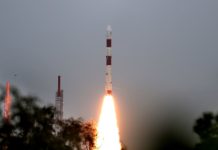Yesterday, at 5.08 pm IST (GMT +5:30), India’s space agency ISRO launched geostationary communications satellite GSAT-29, using its new GSLV Mark III launch vehicle. GSAT-29 is the heaviest satellite India has ever launched.
The flight, known as GSLV MkIII-D2 to mark the rocket’s second developmental flight, lofted the 3423 kg GSAT-29 into Geostationary Transfer Orbit (GTO) from ISRO’s launch site at the Satish Dhawan Space Centre (SDSC) in Sriharikota, in a textbook launch.
Said ISRO Chairman Dr. K. Sivan, “Today, India has achieved a significant milestone in the Indian space programe. I’m extremely happy to declare the heaviest launcher of India, in its second mission, has lifted up the heaviest satellite, GSAT-29, from Indian soil.”
The future of GSLV Mk III
The success of this launch concludes GSLV Mk III’s developmental phase and initiates it into ISRO’s family of operational launchers. Its first operational mission will be the launch of Chandrayaan-2, ISRO’s second lunar mission, which will take place in January 2019. The vehicle will also be used for India’s future human spaceflight programme, planned to commence in 3 years’ time.
Currently, the vehicle is gradually being upgraded to increase its payload capability to 4 tonnes, with a view to reach a 6-tonne capability using a semi-cryogenic second stage. The ISRO team is also working to increase the launch frequency of the GSLV Mk III – currently, ISRO is equipped to handle 2-3 GSLV Mk III launches per year, but will try to increase it to 4-5 launches per year to keep up with demand.
GSLV-Mk III is three-stage vehicle with two solid motor strap-ons, a liquid propellant core stage and a cryogenic stage. The rocket is theoretically capable of launching 4 ton class of satellite to Geosynchronous Transfer orbit (GTO). Yesterday marked the second flight of the vehicle, which was introduced last year on 5 June, with its maiden launch carrying GSAT-19. The vehicle – India’s heaviest launcher yet – is significant for ISRO because it represents a breakthrough in India’s cryogenic capabilities, and is the fruit of a long battle for cryogenic technology that began in the early 90s.
GSAT-29 & upcoming GSAT launches
GSAT-29 is a multi-beam, multiband communication High Throughput Satellite, which carries Ka/Ku-band high throughput communication transponders to connect users in Jammu & Kashmir, as well as North-Eastern India.
Additionally, the satellite carries three advanced technology demonstration payloads – a Q/V-band payload, configured for technology demonstration at higher frequency bands; a Geostationary High Resolution Camera; and an optical communication payload for data transmission from GEO to ground.
Said P. Kunhikrishnan, Director U R Rao Satellite Centre (URSC), “By the end of this month, yet another communications satellite, GSAT-7A will be launched in mid-December. Our largest satellite, GSAT-11 – a HTS satellite having a throughput of 16 Gbps is getting ready for launch at Kourou, French Guiana, on December 4”.







